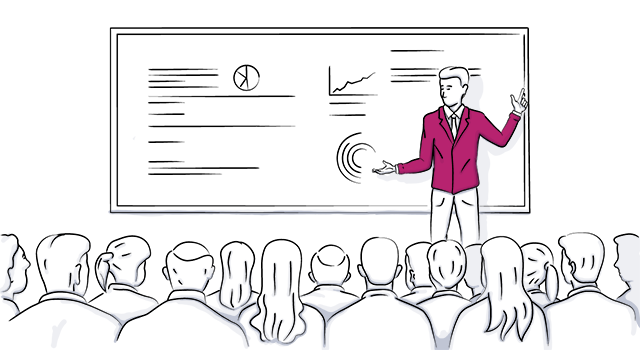
How to Create a Long-Term Event Planning Timeline
When you start planning an event, one of the first things you should do is figure out your event planning timeline. It’s important to outline the months and weeks leading up to the big day. This way, you’ll be sure to meet important deadlines, stay within budget, and coordinate multiple parties smoothly.
The next time you start to plan an event, consider using this helpful guide to create an event planning schedule that works for you. But first, a quick definition.
What is a long-term event planning timeline?
Event timelines ” a sequence of events at defined dates ” are often used for project management. Because event planning is a lot like project managing, it makes sense that planners use event timelines all the time.
A long-term event planning timeline refers to a chronological series of events and actions that take place over a period of time. That period of time, in the event planning world, is often 6 to 12 months total. It sounds like a wide range, and that’s to account for complexity and size. Six months might be a long timeline for relatively simple events; 12 months might be appropriate for a large-scale event with thousands of attendees.
Most event planners find that a long-term event planning timeline helps make sure each and every task is accounted for and completed well in advance of the actual event.

Long-term timeline vs. day-of timeline
Most event planners are familiar with creating a day-of timeline. As the name implies, the day-of timeline lays out all events and tasks that take place on the actual date of the event.
This type of timeline is also essential to the event planning process, but a long-term timeline is just as mission-critical. In fact, a long-term timeline can actually benefit your day-of timeline because it set you up for success.
It also leaves flexibility in your schedule. For instance, you can add in “buffer time” to deal with other issues as they come up, instead of rushing through essential tasks that you could have done earlier.
Why do you need a long-term event planning timelines?
Long-term event planning timelines have even more benefits than the ones we’ve already pointed out. Here are some other ways this master planning guide can help:
- You can get on the same page with vendors and caterers well in advance. This way, they know what to do when they arrive at the event.
- It takes careful planning to pay deposits on time and keep track of contracts. A long-term event planning timeline (written or drawn) can help you keep track of these details.
- Key stakeholders can approve or tweak event planning decisions with plenty of time left over to make alterations. This will keep investors, sponsors, and partners happy throughout the entire process.
There’s really no end to the benefits of organizational tools like timelines. When creating a long-term timeline, there are some key best practices and creative ideas you should incorporate into the process.

3 event planning timeline creation tips
1. Establish anchors.
Anchors are non-negotiable deadlines that are often determined by key stakeholders and partners. They’re events that can’t be moved. Some examples of timeline anchors include:
- A corporate client’s request to have a formal check-in meeting about the event two weeks before.
- Your keynote speaker requests that you ask about their availability and schedule their appearance three months in advance.
- You determine that, because you’re planning an event during peak season, you need to securing event sponsors six months in advance.
As you can tell, all of these anchors have a couple of important things in common:
- They’re out of your control. As an event planner, the most you can do is request schedules from key participants and hope they fit with your plan. This is why booking these partners in advance is so important.
- They’re not flexible. If your client tells you to secure a venue by the end of the month, you can’t wait till next month to deliver a location just because it works better with your schedule. Unless you’re told otherwise, these anchors are written in stone.
- They give you parameters. This is actually a good thing. Once the anchors are established, you’re working within specific parameters. These guidelines will actually make your event planning process easier and more creative. It’ll be your role to fill in the blanks with all the other (less time-bound) event planning tasks.
- After documenting these anchors, you can add in the common event timeline milestones that we’ve written about below.
[Tweet “A long-term event planning timeline helps make sure every task is completed well in advance of the actual event.”]
2. Add vendor timelines.
Event suppliers also play a large role in your long-term event planning timeline. To provide the best possible service, they need to know what’s happening and when. Large events like conferences and trade shows require more planning on their part as well, so you can set them up for success by giving them as much information as you can.
When gathering vendor timelines, here are a few things you can ask:
- How long it takes for the caterer to prepare and serve a seated dinner for 500 people.
- What day your bottled water delivery will arrive and how much time they’ll need to unload.
- What other events are happening at the venue before or after your event, and how they might affect your schedule.
All in all, vendors can only work with the information you give them. And while they’re professionals who are well versed in the art of live events, they’ll be relieved to understand your planning timeline.
When you do share your timeline with vendors, ask them to confirm that they received and reviewed it so there will be no excuses for missed communication.
3. Create multiple drafts of your timeline.
If you want your event timeline to be as efficient as possible, you’ll want to make a few different versions. Iterate on your timeline draft, then do it again. Each new rendition will give you new insights and creative ideas.
Once you’ve created a draft you’re happy with, run it by a trusted colleague. Ask them if you’ve missed any important details. Things like venue reservations, catering deposits, and rental form submissions are easy to miss.
You can then share your drafts with key stakeholders and vendors once again. They’ll either give you updates, or you’ll get their seal of approval, which will help you move forward with confidence in your plan.
Also, be sure to add in wiggle room before you finalize your long-term event planning timeline. Things come up, plans change, and the best thing you can do is give yourself time to navigate all the bumps in the road. Some potential issues that could require scheduled buffers include:
- The printer you hired suddenly closes before printing your order.
- A major sponsor who was responsible for your leading keynote speeches pulls out and you have to find replacements.
- The catering company you hired double booked themselves and can only supply a portion of your food and beverage orders.
While we hope none of these things happen, they sometimes do. A little wiggle room in your schedule could help mitigate these issues. Consider it your event planning insurance for one of your most scarce resources: time.
If you’ve never made a long-term event planning timeline before or just need a refresher, here are some tasks you can include when scheduling your most corporate and private events.
What should be on your event planning timeline
Events like seminars, multi-day workshops, and weddings require six months or more of preparation.
If you’re planning something relatively smaller, like a corporate meeting, you might not need six months. But the extra time will give you the opportunity to plan trickier items like travel arrangements.

6 – 12 months out
If your event has a lot of moving parts or multiple tracks, add these items to your long-term event planning timeline:
- Assign roles and tasks. Who is responsible for what, and when do they need to do it by? Keep track of this information with a spreadsheet. In the columns, indicate whether the task has been completed and add notes.
- Establish event goals. Your event goals and objectives pave the way for most of your decision making. It takes time to properly articulate goals that are both achievable and agreed upon by the whole team.
- Determine the event budget. Determining your event budget six to twelve months in advance helps keep your financials on track. It can also help give you an idea of what kinds of “extras” you can offer at the event.
- Choose your venue, caterer, and other main vendors. Your venue might already have a list of vendors they work with ” you can start there. If they don’t, ask for their recommendations. Coordinating schedules and reserving a spot on their calendar now will help eliminate headaches in the future.
- Make a plan for marketing and event promotion. Decide how you’ll market and promote your event. If you do this early in the process, you’ll have an easier time maintain a cohesive image. If you plan to offer presale tickets or registrations, decide on release dates for them.
3 – 6 months out
The tasks listed below require both research and getting responses from other stakeholders. That’s why we suggest doing these these at least three months out. You’ll have enough time budgeted for each action.
- Choose the remaining vendors. You can book entertainers, florists, and photographers a little later than other vendors. And since each vendor’s pricing will vary, you can reassess your event budget for these suppliers after you’ve already prioritized your other main vendors.
- Confirm speakers and gather biographies. Confirm all your event speakers or special guests. And be sure to get any details you’ll need for your programs as you begin to promote your featured names.
- Make a supplies list and place orders. The supplies you order might be determined by how much of your budget is leftover from the bigger purchases. If you don’t quite have as much cash as you need, you still have time to fundraise or move things around.
- Create emergency plans. Safety is a top concern for all events. Find out about the venue’s safety protocols and evacuation plans. Filling in the gaps with missing details can be time-consuming, which is why this should be completed well in advance.
1 – 3 months out
Without your event planning timeline, you’d be feeling a lot of pressure at this point. But with a schedule, you’ll feel confident about putting the final puzzle pieces in place. There are just a few more tasks to take care of:
- Send invitations. Depending on the type of event you’re planning, it’s time to send invitations. Whether it’s via snail mail or digital messaging, sending invitations now gives attendees plenty of time to prepare their own travel, work schedule, and accommodations.
- Confirm vendor orders. Check in with caterers and other vendors to make sure they received your order and can still deliver on all your requests. If you receive RSVPs beforehand, you can then give your vendors an updated headcount.
- Discuss the venue’s timelines with vendors. It’s important to discuss set up and take down with every member of the team. If someone needs to get in earlier than everyone else, you can check with the venue ahead of time to see if it’s possible.
In conclusion: Create an event master plan
With the help of these definitions, tips, and guidelines, creating your own long-term event planning timeline should be a breeze. Combine this with your day-of timeline to create a successful event master plan. As long as your timelines match up with your event vision, your next big shindig should go off without a hitch.
Ready to learn more about how to plan an event? Here’s how to create introvert-friendly events.
Still have questions about event planning timelines?
1. Establish anchors (non-negotiable deadlines determined by key stakeholders and partners)
2. Determine vendor timelines and build out the various stages of your event timeline around those factors
3. Prepare multiple drafts and be ready to adapt
For a large event with speakers, many attendees, and/or complicated logistics, we recommend at least 6 months of time to plan.

